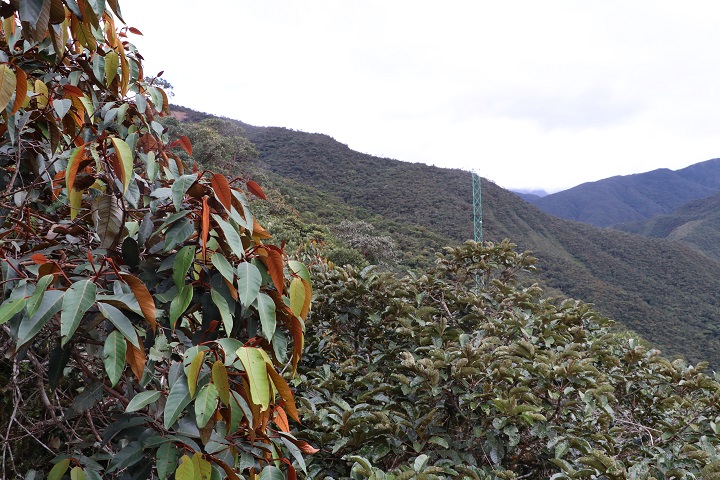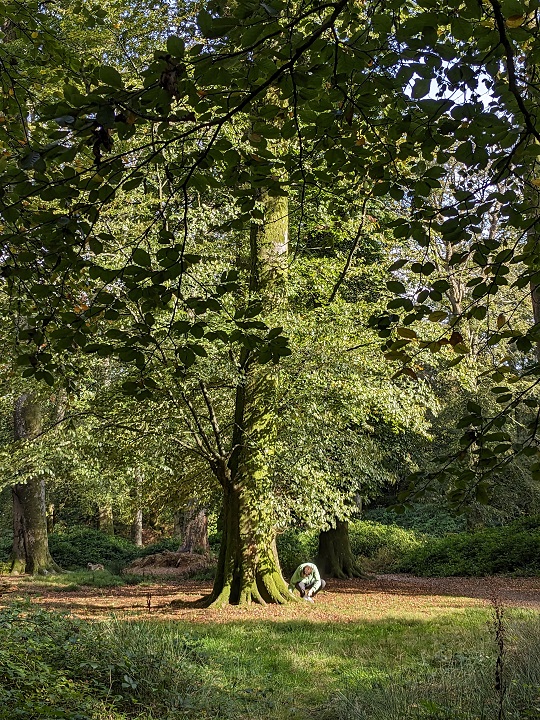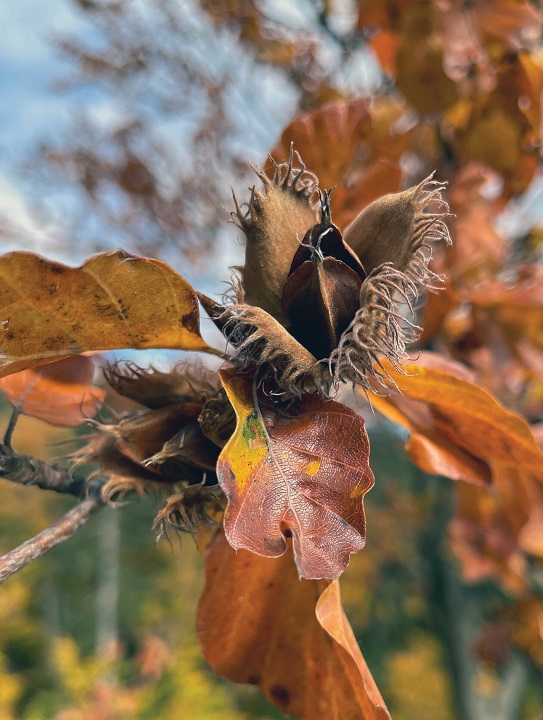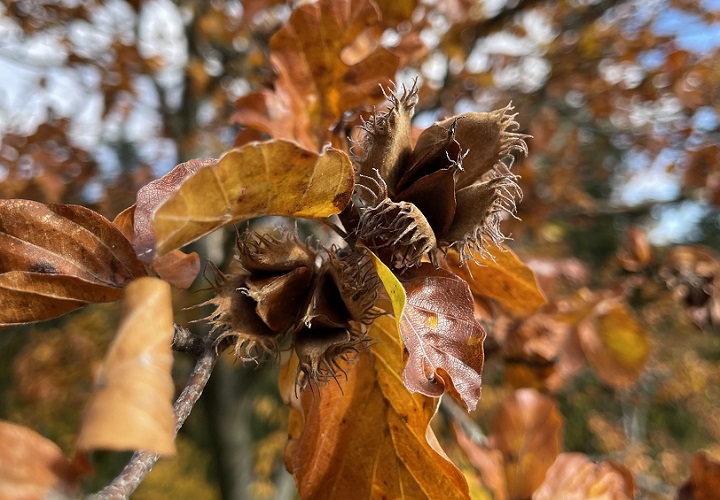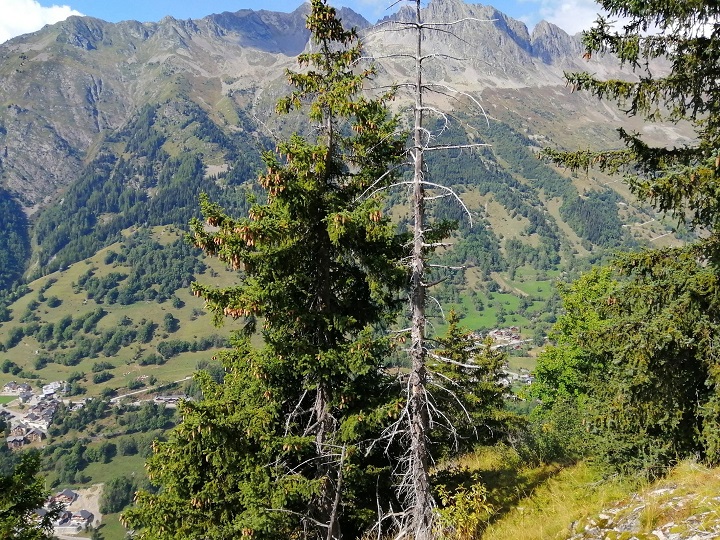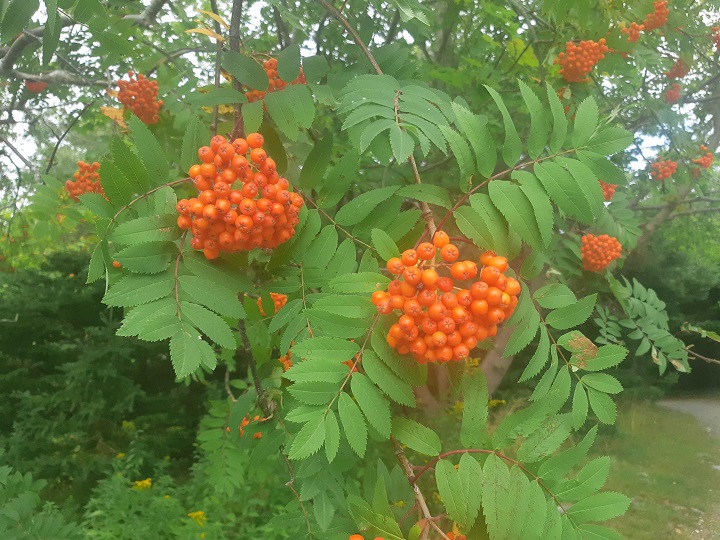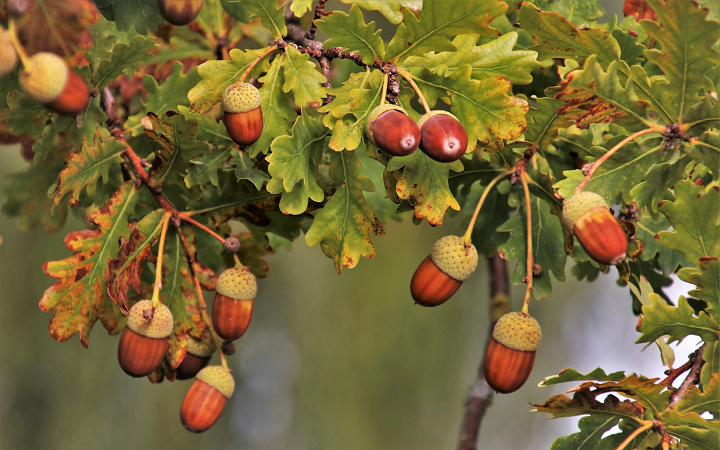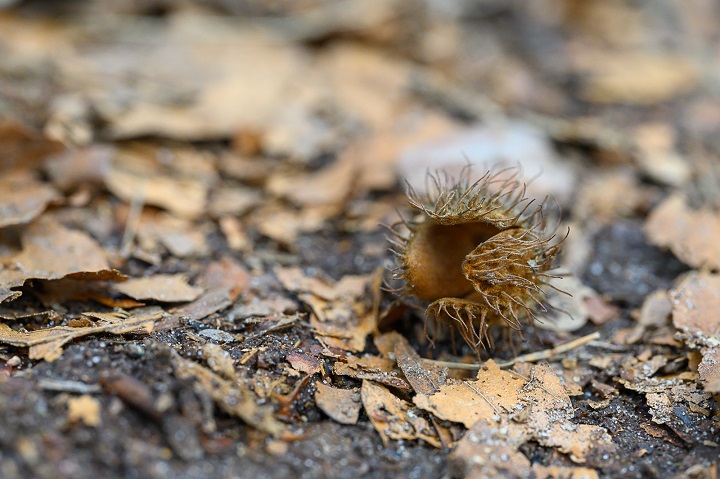In our new paper, just published in New Phytologist, we used extensive long-term observations of snow tussocks (Chionochloa pallens) and European beech (Fagus sylvatica) to explore how plant resources and weather cues interact to influence mast seeding. Our results highlight a key finding: when plants have abundant internal resources, they respond strongly to even moderate weather cues, triggering substantial reproductive events. Conversely, low resource reserves significantly dampen reproductive responses, even under strong cues. This interaction between resource reserves and weather cues improves our understanding of masting mechanisms, offering valuable insights for forecasting seed production—crucial for managing ecosystems and adapting to climate change. The full paper can be accessed here.
Oikos: zależności między cechami a środowiskiem w górskich lasach tropikalnych w Ekwadorze
Górskie lasy tropikalne to unikalne ekosystemy charakteryzujące się wyjątkową różnorodnością gatunkową. Górskie lasy tropikalne znane też jako lasy mgliste położone są na zboczach wysokich gór, np. Andów, gdzie warunki środowiskowe płynnie zmieniają się wraz z gradientem wysokości przyczyniając się do wysokiego stopnia różnorodności tych ekosystemów. Wysoka różnorodność gatunków jest również odzwierciedlona w wysokiej różnorodności funkcjonalnej tych ekosystemów. Cechy funkcjonalne roślin są powiązane z ich strategiami życiowymi, a ich udział w zbiorowiskach roślin może zmieniać się wraz z lokalnymi warunkami oraz dostępem do zasobów. Poprzednie badania wykazały, że wybrane cechy roślin mają tendencję malejącą wraz z wzrostem wysokości, ale wciąż nie jest wiadomo jak udział cech funkcjonalnych różnych etapów życia roślin zmienia się w zależności od lokalnych warunków i wysokości bezwzględnej. W naszych badaniach wykazujemy, że specyficzna powierzchnia liści (SLA czyli proporcja powierzchni liścia do jego suchej masy) u dorosłych drzew, masa nasion w deszczu nasion oraz początkowa wysokość siewek u najmłodszych drzew konsekwentnie zmniejszają się wraz z rosnącą wysokością bezwzględną w lasach mglistych południowego Ekwadoru. Wykazaliśmy też, że ta kompozycja cech w zbiorowiskach leśnych zmienia się w zależności od lokalnych warunków glebowych i dostępności do światła. Nasze badania podkreślają rolę warunków klimatycznych wzdłuż gradientów wysokościowych oraz lokalnych warunków środowiska dla kształtowania się zbiorowisk leśnych w lasach mglistych oraz na rzadko badany aspekt ontogenezy w związkach pomiędzy cechami roślin a środowiskiem w lasach tropikalnych. https://doi.org/10.1111/oik.10421
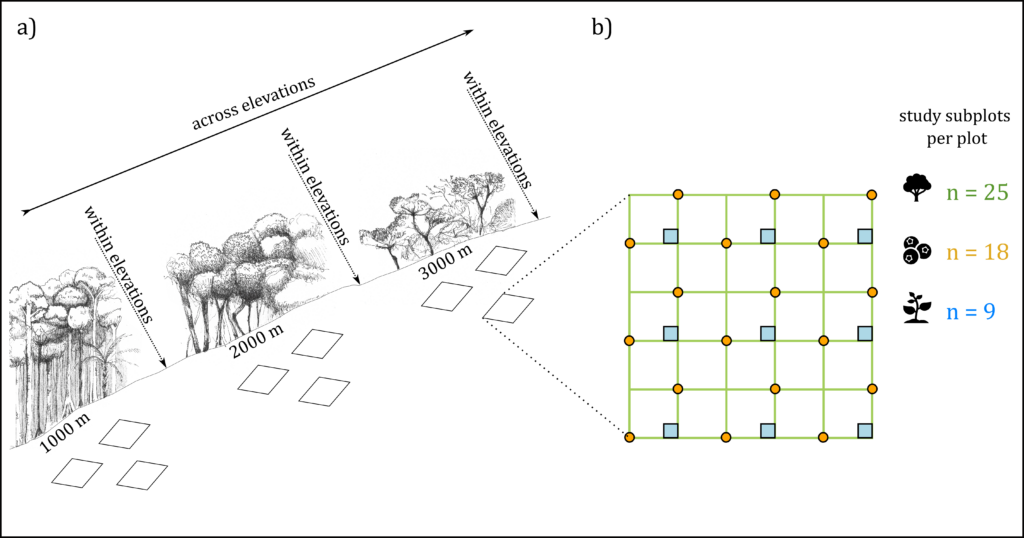
J Applied Ecology: Livestock as biological paste control in oak savannas
In our new paper, just published in Journal of Applied Ecology, we suggest intensifying livestock predation on prematurely dropped-infested acorns by allowing livestock foraging from October 1st onward. Pigs are usually released free range in early November, once weevil larvae have completed their development and escaped predation. The proposed management would increase the availability of healthy acorns, thus increasing the farm capacity and the economic profit by up to 20%, tens of millions of euros of additional profits when translated into the prices of the Iberian pork market. https://doi.org/10.1111/1365-2664.70012
ForEcoMan: Time for efficient seed sampling
Seed production varies widely over time (masting), with many cascading effects on the ecosystem. This makes long-term monitoring essential for forest management and conservation. Traditional methods, such as seed traps and quadrat sampling, are labour-intensive, resource-demanding, and prone to issues like trap destruction or limited canopy visibility. Our latest study demonstrates that the ground-based timed count method is a fast, reliable alternative for monitoring seed production in European beech (Fagus sylvatica). We found a strong loglinear relationship between timed counts and the traditional quadrat-based method, confirming its accuracy. This suggests that timed counts can significantly reduce the cost and effort required for seed monitoring, enabling broader and more efficient sampling.
Interestingly, differences between these methods may influence masting metrics, particularly at the species level. This variation appears to be linked to the patchiness of seedfall, with timed counts capturing greater variability at low seedfall levels. Refining and calibrating cost-effective monitoring techniques will improve large-scale seed production assessments, strengthening our ability to track forest dynamics in a rapidly changing environment.
PNAS: masting breakdown leads to growth decline in European beech
Our latest study, published in PNAS, reveals an indirect impact of climate change on European beech (Fagus sylvatica). Over a 43-year period, rising summer temperatures have increased the frequency of masting, leading to greater reproductive investment at the cost of tree growth. Despite no significant change in summer drought, annual growth rates have declined by 28% due to resource depletion. This shift reduces carbon uptake and disrupts future reproductive success, creating a negative feedback loop. Our findings highlight a previously unrecognized mechanism by which climate change threatens forest sustainability, stressing the need to consider interactions between demographic processes when assessing species vulnerability to climate change.
https://www.pnas.org/doi/abs/10.1073/pnas.2423181122
Annals of Botany: Masting Ontogeny
Our recent study examined how tree size affects the reproductive benefits of masting—a phenomenon where trees synchronize seed production across years, alternating between low and high yield periods. Using data from a 43-year monitoring of European beech (Fagus sylvatica), we found that larger trees benefit most from masting through significantly enhanced pollination efficiency and reduced seed predation during peak seed production years. Specifically, large trees saw larger decrease in seed predation and stronger boost in pollination efficiency compared to smaller trees, which experienced more moderate gains. Interestingly, despite these advantages, larger trees did not allocate a greater share of their reproduction to these high-yield years compared to smaller trees, suggesting limitations or strategic reproductive behavior.
Our study suggests that this seemingly suboptimal allocation by large trees might be due to anatomical constraints, bet-hedging to avoid failures when synchrony with neighboring trees is imperfect, or diminishing returns on reproductive efficiency as seed output increases. While larger trees face higher reproductive costs in off-years, their strategy may balance long-term success by investing more in intermediate-yield years. These findings highlight the complex interplay between tree size, reproductive behavior, and ecological strategies, with implications for understanding forest regeneration, conservation, and climate change resilience.
Read the full story here: https://doi.org/10.1093/aob/mcae197
Ecology Letters: Trees do not wait so long before being reproductive
The fundamental trade-off between current and future reproduction has long been seen as a factor influencing the tendency of species that can reach large sizes to begin reproduction at larger sizes. However, estimates of the size at which trees mature remain scarce due to the extended time required to reach maturity. Because of that long term maturity stage, and limited data, we are lacking of a comprehensive view of the trade-off between tree at maturity and maximum size.
In our last study, we used more than 10 million of observation of seed production data with tree size from five continents. We were able to estimate the maturation size of 486 tree species, covering climates ranging from tropical to boreal.
Our results showed that the size at maturity of tree species increases with their maximum size, but not proportionally as we would initially expect based on evolutionary theory. We found that the largest species begin to reproduce at smaller sizes than would be expected if maturation were simply proportional to maximum size (see the illustration just bellow).

Figure for illustrative purpose: Trees do not wait too long before being able to reproduce (blue dotted line). Instead, large trees species can be already reproductive at smaller size (plateau, brown plain line).
This phenomenon is particularly marked in cold climates, where the reduction in relative maturation size is most abrupt. These results provide new insights into forest dynamics and species responses to disturbance and climate change. We now know a little more about when trees start to reproduce! Read the full story:
https://onlinelibrary.wiley.com/doi/abs/10.1111/ele.14500
Ecology Letters: masting and reproductive efficiency
Our recent study focusing on rowan trees (Sorbus aucuparia) sheds light on how these trees optimize their reproductive efficiency through synchronized and variable seed production.
Mast seeding is a strategy where trees forego reproduction in some years to produce a bumper crop of seeds in others, often in sync with neighboring trees. This boom-and-bust cycle has significant impacts on ecosystems, influencing food webs and nutrient cycling. But why do trees adopt this seemingly risky strategy? The key lies in reproductive efficiency—the effectiveness of converting resources into successful offspring. By synchronizing large seed production events, trees can overwhelm seed predators, ensuring that a higher proportion of seeds escape being eaten. Additionally, synchronized flowering increases pollination success, as pollinators are more likely to visit trees when many are in bloom simultaneously.
In this study, we tracked 209 rowan trees over 23 years, recording their fruit production patterns. We used genetic analysis to determine which seedlings originated from which trees, allowing them to measure each tree’s reproductive success in terms of the number of established offspring. The findings revealed that trees with high interannual variability in fruit production had higher reproductive efficiency, but only if they synchronized their fruiting with other trees. These trees benefited from the economies of scale that mast seeding provides, such as reduced seed predation and improved pollination. Conversely, trees that varied their fruit production but did so out of sync with others experienced lower reproductive efficiency. They missed out on the benefits of synchrony while still bearing the costs associated with intermittent reproduction. Interestingly, trees that reproduced regularly but did not synchronize with others achieved the highest reproductive efficiency per fruit. However, these trees typically had lower overall fecundity—they produced fewer fruits on average. This suggests a trade-off between maximizing reproductive efficiency and producing a large number of seeds.
By linking long-term ecological data with genetic analyses, we provided compelling evidence that mast seeding enhances reproductive efficiency beyond the seed stage. This means that the benefits of mast seeding persist through seedling establishment and contribute to the evolutionary success of this reproductive strategy. These insights help explain why mast seeding has evolved and persisted in various tree species. They highlight the delicate balance trees must strike between synchronizing with their neighbors to gain collective benefits and managing the individual costs associated with variable reproduction. Read the full story: https://onlinelibrary.wiley.com/doi/10.1111/ele.14514
Forest Ecology and Management: community-wide masting enhances predator satiation
Mast seeding, or masting, is a fascinating reproductive strategy observed in many perennial plants, where individuals within a population produce seeds in highly variable quantities from year to year. This synchronized fluctuation in seed production among plants has long intrigued ecologists, primarily because it offers a significant survival advantage: it helps reduce the impact of seed predators. By alternating between years of seed scarcity and abundance, plants can effectively „starve” predators in low-yield years and „satiate” them in high-yield years, ensuring that more seeds survive to germinate.
The relationship between masting and environmental conditions, particularly weather, is well-established. Plants often synchronize their masting events in response to weather patterns, leading to widespread seed production across species. While this interspecies synchronization could theoretically enhance the predator satiation effect, it has not been thoroughly studied until now.
In a recent study, we tested this hypothesis by analyzing 23 years of data on seed production and pre-dispersal seed predation in three North American oak species: Quercus rubra (red oak), Quercus alba (white oak), and Quercus montana (chestnut oak). The study revealed that weather patterns, particularly those in spring and summer, were correlated with masting events in all three oak species. This correlation led to varying degrees of synchronization within each species, ranging from 21% to 38%.
Interestingly, the study found that this intraspecific synchrony—where individuals of different species mast together—played a crucial role in reducing seed predation. For Q. rubra and Q. alba, synchronized masting resulted in efficient starvation of seed predators, significantly reducing seed losses. However, for Q. montana, it was the community-wide masting events, where multiple oak species produced seeds simultaneously, that were necessary to satiate the predators effectively.
These findings provide rare empirical evidence supporting the idea that synchronized masting within a species can enhance reproductive success by minimizing seed losses to predators. Moreover, the study suggests that forests with diverse oak species might have better regeneration potential due to the increased likelihood of community-wide masting events. This insight could inform forest management practices, emphasizing the importance of species diversity to boost seed survival and forest regeneration.
Ecology Letters: synchrony of mast peaks and troughs
Ever wondered why some years your favorite forest is overflowing with beech nuts, and other years it’s almost barren? This feast-or-famine cycle, known as masting, is not just random. Our recent research reveals a fascinating pattern: European beech trees are synchronizing their seed production across vast distances, but intriguingly, they do so differently for bumper crop years compared to lean ones.
Masting refers to the high variation in seed production that some perennial plants exhibit from year to year. Imagine a forest where, one year, beech trees are heavy with seeds, and the next, they’re nearly bare. This phenomenon isn’t just a local quirk; it can happen simultaneously across regions spanning hundreds of kilometers. Researchers have been curious to understand whether these peaks (high seed years) and troughs (low seed years) in seed production are synchronized differently.
We delved into this question by studying 99 populations of European beech trees (Fagus sylvatica) across Europe. We discovered that while mast peaks (years of high seed production) are synchronized up to 1000 kilometers apart, the years of seed scarcity are synchronized across even larger distances, up to 1800 kilometers.
This spatial synchrony is more concentrated in northeastern Europe for mast peaks, while seed scarcity spans almost the entire range of the species. This extensive synchrony in low seed years means that when beech trees experience a bad year, it’s felt widely, creating resource famines that can ripple through ecosystems.
Such extensive synchrony in seed scarcity has important implications. It can lead to resource pulses or famines, impacting food webs significantly. Animals that rely on beech seeds for food may face widespread shortages, affecting their populations and behavior. This, in turn, can influence predator-prey dynamics, biodiversity, and even forest health.
Understanding these patterns is crucial in the context of climate change. As weather patterns shift, the synchrony in masting may alter, potentially leading to more frequent or severe resource pulses and famines. This can affect not only the plants and animals directly involved but also the broader ecological and climatic systems.


